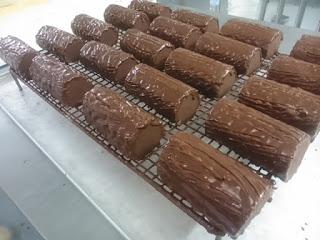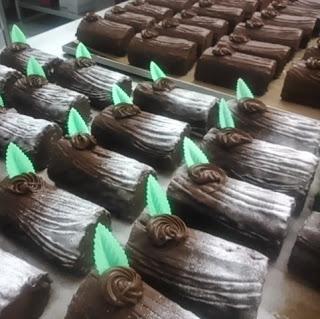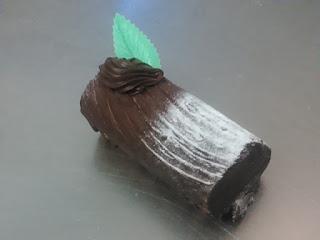 De origen francés, el Tronco
de Navidad, o tronco navideño, es un postre tradicional que se sirve hoy en día
durante las Fiestas de fin de año en varios países europeos, aunque mucho más
popular evidentemente en Francia y en otros países de influencia francófona.
Originally born in France, the
Christmas Log is a traditional dessert, served today during Christmas and New
Year festivities in many European countries. However, it is obviously more
popular in France
and in other French influenced countries.
De origen francés, el Tronco
de Navidad, o tronco navideño, es un postre tradicional que se sirve hoy en día
durante las Fiestas de fin de año en varios países europeos, aunque mucho más
popular evidentemente en Francia y en otros países de influencia francófona.
Originally born in France, the
Christmas Log is a traditional dessert, served today during Christmas and New
Year festivities in many European countries. However, it is obviously more
popular in France
and in other French influenced countries.
 El origen de la Bûche de Noël (tronco de
Navidad) es pagano, pues en la antigüedad, se quemaba un tronco de madera,
generalmente procedente de un árbol frutal, para celebrar el solsticio de
invierno y el fuego del año nuevo, a punto de empezar. El mayor o el menor de
la familia era el encargado de encender el fuego, el cual tenía que durar tres
días mínimo. El tronco se regaba con vino o aceite. Este ritual podría proceder
de tribus germánicas del norte de Europa pero se practicaba también en otros
países, como en las Islas Británicas, donde se conocía con el nombre Yule log
(los pueblos Celtas se referían a Yule como ese periodo del año). El siglo XIX
y la llegada de las estufas en lugar de chimeneas modificó esta tradición en la
que conocemos hoy: la del postre.
El origen de la Bûche de Noël (tronco de
Navidad) es pagano, pues en la antigüedad, se quemaba un tronco de madera,
generalmente procedente de un árbol frutal, para celebrar el solsticio de
invierno y el fuego del año nuevo, a punto de empezar. El mayor o el menor de
la familia era el encargado de encender el fuego, el cual tenía que durar tres
días mínimo. El tronco se regaba con vino o aceite. Este ritual podría proceder
de tribus germánicas del norte de Europa pero se practicaba también en otros
países, como en las Islas Británicas, donde se conocía con el nombre Yule log
(los pueblos Celtas se referían a Yule como ese periodo del año). El siglo XIX
y la llegada de las estufas en lugar de chimeneas modificó esta tradición en la
que conocemos hoy: la del postre.
 The origin of the Bûche
de Noël (Christmas Log) is pagan. Indeed, a wood log, generally coming from a
fruit tree, was previously burnt to celebrate the winter solstice and the fire
of the New Year, about to begin. The oldest or the youngest person of the
family was in charge of starting the fire that had to last for at least three
days. Wine or oil was poured on the log. This ritual may come from German
tribes from the north of Europe, but it was also common in other countries,
like for example in the British islands, where it was known as Yule Log (the
Celtic people called Yule this time of the year). The XIX century and the
arrival of heaters instead of chimneys modified this tradition into what we
know today: the dessert.
The origin of the Bûche
de Noël (Christmas Log) is pagan. Indeed, a wood log, generally coming from a
fruit tree, was previously burnt to celebrate the winter solstice and the fire
of the New Year, about to begin. The oldest or the youngest person of the
family was in charge of starting the fire that had to last for at least three
days. Wine or oil was poured on the log. This ritual may come from German
tribes from the north of Europe, but it was also common in other countries,
like for example in the British islands, where it was known as Yule Log (the
Celtic people called Yule this time of the year). The XIX century and the
arrival of heaters instead of chimneys modified this tradition into what we
know today: the dessert.
 La invención del
Tronco de Navidad como postre es más confusa: algunos atribuyen esta creación a
un aprendiz de una chocolatería del barrio de Saint-Germain-des-Prés (Paris) en
1834, otros al pastelero Bonnat de Lyon, quien elaboraba un tronco helado con
ganache de chocolate en 1860. Sin embargo, una de las hipótesis más plausible
sería la de su creación por Pierre Lacam, pastelero y heladero, quien publicó
la receta de un Tronco de Navidad elaborado con mazapán, helado y chocolate, en
1898.
La invención del
Tronco de Navidad como postre es más confusa: algunos atribuyen esta creación a
un aprendiz de una chocolatería del barrio de Saint-Germain-des-Prés (Paris) en
1834, otros al pastelero Bonnat de Lyon, quien elaboraba un tronco helado con
ganache de chocolate en 1860. Sin embargo, una de las hipótesis más plausible
sería la de su creación por Pierre Lacam, pastelero y heladero, quien publicó
la receta de un Tronco de Navidad elaborado con mazapán, helado y chocolate, en
1898.
 The creation of the Christmas
Log as a dessert is more unclear: some people attribute it to a trainee in a
chocolate shop, in the Saint-Germain-des-Prés (Paris)
neighbourhood in 1834, other people think it comes from the pastry chef Bonnat
in Lyon, who prepared a frozen log with
chocolate ganache in 1860. However, one of the most plausible theory is that it
was created by Pierre Lacam, pastry and ice-cream chef, who published in 1898
the recipe of a Christmas Log, prepared with marzipan, ice-cream and chocolate.
The creation of the Christmas
Log as a dessert is more unclear: some people attribute it to a trainee in a
chocolate shop, in the Saint-Germain-des-Prés (Paris)
neighbourhood in 1834, other people think it comes from the pastry chef Bonnat
in Lyon, who prepared a frozen log with
chocolate ganache in 1860. However, one of the most plausible theory is that it
was created by Pierre Lacam, pastry and ice-cream chef, who published in 1898
the recipe of a Christmas Log, prepared with marzipan, ice-cream and chocolate.
Tradicionalmente, el Tronco de Navidad se confecciona con un bizcocho esponjoso, rectangular y plano, el cual se unta con crema de mantequilla de chocolate, café o praliné. A continuación, se enrolla hasta obtener un cilindro y se unta con crema la parte de fuera. Sin embargo, hoy en día existen muchas variaciones, tanto en los bizcochos, como en las cremas y en los rellenos. Algunos también lo preparan con mazapán y el helado está a la orden del día. Traditionally, the Christmas Log is prepared with a spongy, rectangular and flat cake, spread with chocolate, coffee or praline butter-cream. Then, it is rolled up until it becomes a cylinder, and the part outside is spread with the butter-cream. Nevertheless, nowadays, there are many variations, with the cakes as well as with the creams and fillings. Some people also prepare it with marzipan and the ice-cream is in fashion too.

